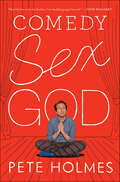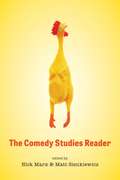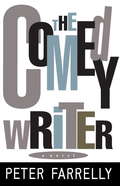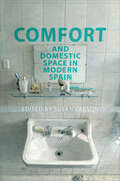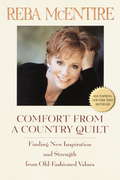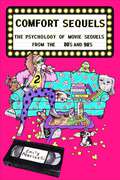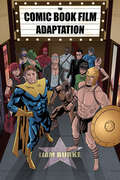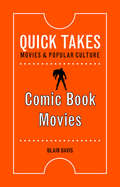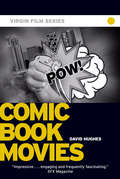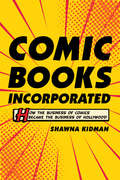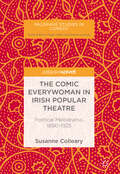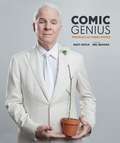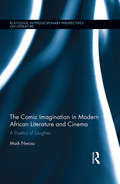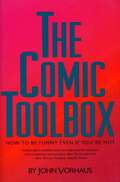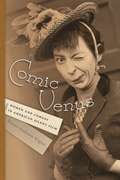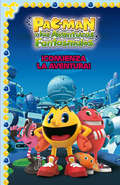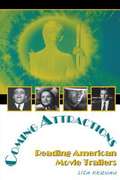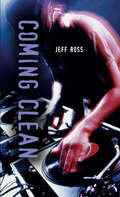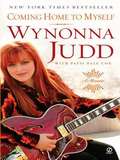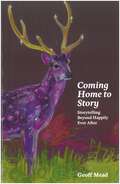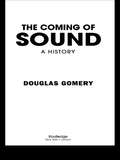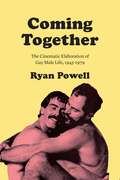- Table View
- List View
Comedy Sex God
by Pete HolmesThe standup comic, podcaster, and HBO star explores the role of religion in his life in this blend of memoir, philosophical inquiry, and spiritual quest.Pete Holmes is a sold-out-every-night stand-up comedian with two HBO specials and the host of the hugely successful podcast You Made It Weird, and he was the creator-star of the hit HBO show Crashing. But it wasn’t always roses for Pete. Growing up, Pete was raised an evangelical Christian, but his religion taught him that being “bad”—smoking, drinking, having doubts or premarital sex—would get him sent to an eternity in hell. So, terrified of the God he loved, Pete devoted his life to being “good,” even marrying his first girlfriend at the age of twenty-two only to discover a few years later he was being cheated on. Thanks for nothing, God.Pete’s failed attempt at a picture-perfect life forced him to reexamine his beliefs, but neither atheism, nor Christianity, nor copious bottles of Yellow Tail led him to enlightenment. Pete longed for a model of faith that served him and his newfound uncertainties about the universe, so he embarked on a soul-seeking journey that continues to this day. Through encounters with mind-altering substances, honing his craft in front of thousands of his comedy fans, and spending time with savants like Ram Dass, Pete forged a new life—both spiritually and personally.Beautifully written and often completely hilarious—imagine Dass’s Be Here Now if penned by one of the funniest people alive—Comedy Sex God reveals a man at the top of his game and a seeker in search of the deeper meanings of life, love, and comedy.“Pete Holmes is a thoughtful and hilarious contradiction. Centered, but ambitious. Zen, but stressed. He’s like the Buddha if the Buddha Googled himself. This memoir captures all the wonderful inconsistencies and strengths of my very funny friend. It was a joy to read.” —John Mulaney
The Comedy Studies Reader
by Nick Marx Matt SienkiewiczFrom classical Hollywood film comedies to sitcoms, recent political satire, and the developing world of online comedy culture, comedy has been a mainstay of the American media landscape for decades. Recognizing that scholars and students need an authoritative collection of comedy studies that gathers both foundational and cutting-edge work, Nick Marx and Matt Sienkiewicz have assembled The Comedy Studies Reader. This anthology brings together classic articles, more recent works, and original essays that consider a variety of themes and approaches for studying comedic media—the carnivalesque, comedy mechanics and absurdity, psychoanalysis, irony, genre, race and ethnicity, gender and sexuality, and nation and globalization. The authors range from iconic theorists, such as Mikhail Bakhtin, Sigmund Freud, and Linda Hutcheon, to the leading senior and emerging scholars of today. As a whole, the volume traces two parallel trends in the evolution of the field—first, comedy’s development into myriad subgenres, formats, and discourses, a tendency that has led many popular commentators to characterize the present as a “comedy zeitgeist”; and second, comedy studies’ new focus on the ways in which comedy increasingly circulates in “serious” discursive realms, including politics, economics, race, gender, and cultural power.
The Comedy Writer: A Novel
by Peter FarrellyA Confederacy of Dunces meets The Player in an offbeat, sidesplittingly hilarious novel about making it against all odds in 1990s' Hollywood, by the co-writer/director of Dumb and Dumber. When Henry Halloran's girlfriend dumped him, his Boston-based life suddenly seemed pointless. He was thirty-two with a dead-end job, and nothing on the horizon. There was obviously only one place to go: Hollywood. The Comedy Writer is the story of how Henry--armed with nothing more than a few ideas, a nothing-to-lose attitude, and the desire to be a screenwriter--joins myriad hopefuls in the City of Angels and achieves an L.A. kind of fame. From the surreal squalor of his one-room pad at the Blue Terrace apartments, he encounters nympho starlets, death-obsessed Rollerbladers, philosophical midgets, scruple-free producers, and an unforgettably psychotic roommate named Colleen. Combining the mordant wit and insight of Nathanael West with the lyricism and irony of a postmodern Candide, The Comedy Writer is a bawdy romp around and through the dream factory, in which Henry learns that while talent and integrity may be relative terms, life does, after all, have meaning. Sure to appeal to anyone who has ever dreamed of Hollywood success, who has found him- or herself a full-fledged adult without a clue for the future, or who ever thought Los Angeles might represent the end of modern civilization, The Comedy Writer is an incomparable comic tour de force marked by the kind of telling detail only a true insider can provide.
Comfort and Domestic Space in Modern Spain (Toronto Iberic #91)
by Susan LarsonComfort and domestic space are complex narratives that can help draw our attention to everything from urban planning, everyday objects, and new technologies to class conflict, racial and ethnic segregation, and the gendering of domestic labour. Comfort and Domestic Space in Modern Spain delves into the history of ideas surrounding the modern home. It explores how the collective experience of domestic space has been shaped by government ideologues, technocrats, and artists as well as working- and middle-class Spaniards since the late nineteenth century. The book focuses on the social and cultural meanings of domestic space in ways that invite us to cross boundaries between private and public, the particular and the general, the local and the global, and to pay attention to the role of the cultural imagination in making a house into a home. Considering a wide variety of voices and perspectives that have resulted in new ideas about how to inhabit domestic space, Comfort and Domestic Space in Modern Spain brings together an international, interdisciplinary group of scholars to illuminate the cultural history of everyday life.
Comfort from a Country Quilt
by Reba McentireThe New York Times Bestseller That Reads Like a Back-Porch Conversation with Reba!In a dazzling career, Reba McEntire has become a true country superstar--and a trailblazing businesswoman with her own multimedia entertainment corporation. Yet she is a rare celebrity who is also beloved by her millions of fans for the way she lives her life. For Reba has balanced the demands of career and family, succeeded in show business without sacrificing her values, and kept up with the times without abandoning her country roots.Here Reba writes about the roles a modern woman tries to fill, roles as many and varied as the fabric pieces of an heirloom quilt. Facing the challenges of being a wife, mother, stepmother, daughter, sister, performer, executive, community member, and Christian, Reba has found inspiration and comfort in the values of her past as an Oklahoma ranch girl. In this generous and wise book, she shows how you can keep traditional values fresh and vital in your own search for a fulfilling life.Whether you read it for instant warmth or lasting inspiration, Comfort from a Country Quilt is a book that will make your spirits soar like the sweet high notes of a Reba McEntire song.
Comfort Sequels: The Psychology of Movie Sequels from the 80s and 90s
by Emily MarinelliThis sneaky memoir celebrates the campiness and nostalgia of some of the more infamous (some might say underappreciated) sequels of the eighties and nineties, with brand-new interviews with cast and creative team members, while at the same time emphatically conveying the restorative power these films had on the author's traumatic -- sometimes even dangerous -- upbringing. In the late eighties and early nineties, while other kids were playing softball, Emily was sporting a Pink Ladies jacket, perfecting Michelle Pfeiffer&’s &“Cool Rider&” choreography from Grease 2, and wearing out the VHS player. Comfort Sequels: The Psychology of Movie Sequels from the 80s and 90s tells stories from Emily's life, through the movie sequels of their childhood. When a film touches us, makes us deep-belly laugh, and has that feel-good spirit, we want more of it. We want the continuing story. We want the same story even, just recycled and offered in a slightly new way. What felt so good about the original can come back twofold and be the same, but different. Comfort Sequels examines the psychology behind what makes certain movie sequels memorable, safe, predictable, and comforting. These sequels are more of the universe we love—exploring something new while maintaining that which is familiar. Comfort Sequels is a sneaky memoir, celebrating the campiness and nostalgia that these films evoke. Every chapter is a love letter to a specific movie sequel. As a licensed psychotherapist and psychology professor, Emily interprets characters, story arcs, and major themes in a unique voice from a unique perspective while sharing fun and random behind-the-scenes facts about each film. Featuring interviews with Muppeteer Steve Whitmire (creator of Rizzo the Rat from The Great Muppet Caper), Christine Ebersole (My Girl 2), Stuart Pankin (Mannequin 2: On the Move), Peter Mosen (Ghostbusters II), Christopher McDonald and Leif Green (Grease 2), and the &“Cool Rider&” himself, Maxwell Caulfield (Michael, also from Grease 2). Comfort Sequels covers the following twelve comfort sequels; Grease 2, My Girl 2, Karate Kid: Part II, The Great Muppet Caper, Teenage Mutant Ninja Turtles 2: The Secret of the Ooze, Ghostbusters II, Batman Returns, Dream a Little Dream 2, Mannequin 2: On the Move, The Neverending Story II: The Next Chapter, and The Evening Star.
Comic Acting and Portraiture in Late-Georgian and Regency England
by Jim DavisThe popularity of the comic performers of late-Georgian and Regency England and their frequent depiction in portraits, caricatures and prints is beyond dispute, yet until now little has been written on the subject. In this unique study Jim Davis considers the representation of English low comic actors, such as Joseph Munden, John Liston, Charles Mathews and John Emery, in the visual arts of the period, the ways in which such representations became part of the visual culture of their time, and the impact of visual representation and art theory on prose descriptions of comic actors. Davis reveals how many of the actors discussed also exhibited or collected paintings and used painterly techniques to evoke the world around them. Drawing particularly on the influence of Hogarth and Wilkie, he goes on to examine portraiture as critique and what the actors themselves represented in terms of notions of national and regional identity.
The Comic Book Film Adaptation: Exploring Modern Hollywood's Leading Genre
by Liam BurkeIn the summer of 2000 X-Men surpassed all box office expectations and ushered in an era of unprecedented production of comic book film adaptations. This trend, now in its second decade, has blossomed into Hollywood's leading genre. From superheroes to Spartan warriors, The Comic Book Film Adaptation offers the first dedicated study to examine how comic books moved from the fringes of popular culture to the center of mainstream film production.Through in-depth analysis, industry interviews, and audience research, this book charts the cause-and-effect of this influential trend. It considers the cultural traumas, business demands, and digital possibilities that Hollywood faced at the dawn of the twenty-first century. The industry managed to meet these challenges by exploiting comics and their existing audiences. However, studios were caught off-guard when these comic book fans, empowered by digital media, began to influence the success of these adaptations. Nonetheless, filmmakers soon developed strategies to take advantage of this intense fanbase, while codifying the trend into a more lucrative genre, the comic book movie, which appealed to an even wider audience. Central to this vibrant trend is a comic aesthetic in which filmmakers utilize digital filmmaking technologies to engage with the language and conventions of comics like never before.The Comic Book Film Adaptation explores this unique moment in which cinema is stimulated, challenged, and enriched by the once-dismissed medium of comics.
Comic Book Movies (Quick Takes: Movies and Popular Culture)
by Blair DavisComic Book Movies explores how this genre serves as a source for modern-day myths, sometimes even incorporating ancient mythic figures like Thor and Wonder Woman’s Amazons, while engaging with the questions that haunt a post-9/11 world: How do we define heroism and morality today? How far are we willing to go when fighting terror? How can we resist a dystopian state? Film scholar Blair Davis also considers how the genre’s visual style is equally important as its weighty themes, and he details how advances in digital effects have allowed filmmakers to incorporate elements of comic book art in innovative ways. As he reveals, comic book movies have inspired just as many innovations to Hollywood’s business model, with film franchises and transmedia storytelling helping to ensure that the genre will continue its reign over popular culture for years to come.
Comic Book Movies - Virgin Film
by David HughesThe superheroes are back! Since the 1970s, the film world has found inspiration in comic books and graphic novels. These days no summer is complete without a major blockbuster movie based on a comic: Superman, Batman, Spider-Man, X-Men, Men in Black, Daredevil, and The Hulk. Modern special effects have made large-scale superhero epics possible, but the diversity of the comics being published has made for a wide variety of subjects, as evidenced by Ghost World, From Hell, Akira and Road to Perdition. This book looks in detail at twenty key titles, covering every step of the development from comic book panel to feature film frame. Includes interviews with key creative artists about the evolution of the films from the original comics, and speculates about future films.
Comic Books Incorporated: How the Business of Comics Became the Business of Hollywood
by Shawna KidmanComic Books Incorporated tells the story of the US comic book business, reframing the history of the medium through an industrial and transmedial lens. Comic books wielded their influence from the margins and in-between spaces of the entertainment business for half a century before moving to the center of mainstream film and television production. This extraordinary history begins at the medium’s origin in the 1930s, when comics were a reviled, disorganized, and lowbrow mass medium, and surveys critical moments along the way—market crashes, corporate takeovers, upheavals in distribution, and financial transformations. Shawna Kidman concludes this revisionist history in the early 2000s, when Hollywood had fully incorporated comic book properties and strategies into its business models and transformed the medium into the heavily exploited, exceedingly corporate, and yet highly esteemed niche art form we know so well today.
The Comic Everywoman in Irish Popular Theatre: Political Melodrama, 1890-1925 (Palgrave Studies in Comedy)
by Susanne CollearyThis book is a comprehensive study of comic women in performance as Irish Political Melodrama from 1890 to 1925. It maps out the performance contexts of the period, such as Irish “poor” theatre both reflecting and complicating narratives of Irish Identity under British Rule. The study investigates the melodramatic aesthetic within these contexts and goes on to analyse a selection of the melodramas by the playwrights J.W. Whitbread and P.J. Bourke. In doing so, the analyses makes plain the comic structures and intent that work across both character and action, foregrounding comic women at the centre of the discussion. Finally, the book applies a “practice as research” dimension to the study. Working through a series of workshops, rehearsals and a final performance, Colleary investigates comic identity and female performance through a feminist revisionist lens. She ultimately argues that the formulation of the Comic Everywoman as staged “Comic” identity can connect beyond the theatre to her “Everyday” self. This book is intended for those interested in theatre histories, comic women and in popular performance.
Comic Genius
by Matt Hoyle Mel BrooksThis star-studded tribute to the kings and queens of comedy draws together such legendary names as Steve Martin, Tina Fey, Steve Carell, Eddie Murphy, Robin Williams, Ricky Gervais, and many more. Granted extraordinary access, photographer Matt Hoyle has captured his subjects in portraits that are works of art in themselves--by turns zany and deadpan, laugh-out-loud and contemplative. Accompanying them are first-person reflections from each of the comedians on life and laughter that always cut straight to the heart of comedy: it's funny because it's true. Page after sidesplitting page in Comic Genius offers prose as engaging as each portrait is memorable. Here, in one handsome package, is the gift of laughter itself. Comic Genius is proud to support Save The Children.
The Comic Imagination in Modern African Literature and Cinema: A Poetics of Laughter (Routledge Interdisciplinary Perspectives on Literature)
by Maik NwosuThis book is a seminal study that significantly expands the interdisciplinary discourse on African literature and cinema by exploring Africa’s under-visited carnivalesque poetics of laughter. Focusing on modern African literature as well as contemporary African cinema, particularly the direct-to-video Nigerian film industry known as Nollywood, the book examines the often-neglected aesthetics of the African comic imagination. In modern African literature, which sometimes creatively traces a path back to African folklore, and in Nollywood — with its aesthetic relationship to Onitsha Market Literature — the pertinent styles range from comic simplicitas to comic magnitude with the facilitation of language, characterization, and plot by a poetics of laughter or lightness as an important aspect of style. The poetics at work is substantially carnivalesque, a comic preference or tendency that is attributable, in different contexts, to a purposeful comic sensibility or an unstructured but ingrained or virtual comic mode. In the best instances of this comic vision, the characteristic laughter or lightness can facilitate a revaluation or reappreciation of the world, either because of the aesthetic structure of signification or the consequent chain of signification. This referentiality or progressive signification is an important aspect of the poetics of laughter as the African comic imagination variously reflects, across genres, both the festival character of comedy and its pedagogical value. This book marks an important contribution to African literature, postcolonial literature, world literature, comic imagination, poetics, critical theory, and African cinema.
The Comic Toolbox: How To Be Funny Even If You're Not
by John VorhausA workbook approach to comedy writing as creative problem-solving. It offers tools of the trade such as Clash of Context, Tension and Release, The Law of Comic Opposites, The Wildly Inappropriate Response, and The Myth of the Last Great Idea to writers, comics, and anyone else who wants to be funny.
Comic Venus: Women And Comedy In American Silent Film (Contemporary Approaches To Film And Media Ser.)
by Kristen Anderson WagnerFor many people the term “silent comedy” conjures up images of Charlie Chaplin’s Little Tramp, Buster Keaton’s Stoneface, or Harold Lloyd hanging precariously from the side of a skyscraper. Even people who have never seen a silent film can recognize these comedians at a glance. But what about the female comedians? Gale Henry, Louise Fazenda, Colleen Moore, Constance Talmadge—these and numerous others were wildly popular during the silent film era, appearing in countless motion pictures and earning top salaries, and yet, their names have been almost entirely forgotten. As a consequence, recovering their history is all the more compelling given that they laid the foundation for generations of funny women, from Lucille Ball to Carol Burnett to Tina Fey. These women constitute an essential and neglected sector of film history, reflecting a turning point in women’s social and political history. Their talent and brave spirit continues to be felt today, and Comic Venus: Women and Comedy in American Silent Film seeks to provide a better understanding of women’s experiences in the early twentieth century, and to better understand and appreciate the unruly and boundary-breaking women who have followed. The diversity and breadth of archival materials explored in Comic Venus illuminate the social and historical period of comediennes and silent film. In four sections, Kristen Anderson Wagner enumerates the relationship between women and comedy, beginning with the question of why historically women weren’t seen as funny or couldn’t possibly be funny in the public and male eye, a question that persists even today. Wagner delves into the idea of women’s “delicate sensibilities,” which presumably prevented them from being funny, and in chapter two traces ideas about feminine beauty and what a woman should express versus what these comedic women did express, as Wagner notes, “comediennes challenged the assumption that beauty was a fundamental component of ideal femininity.” In chapter three, Wagner discusses how comediennes such as Clara Bow, Marie Dressler, and Colleen Moore used humor to gain recognition and power through performances of sexuality and desire. Women comedians presented “sexuality as fun and playful, suggesting that personal relationships could be fluid rather than stable.” Chapter four examines silent comediennes’ relationships to the modern world and argues that these women exemplified modernity and new womanhood. The final chapter of Comic Venus brings readers to understand comediennes and their impact on silent-era cinema, as well as their lasting influence on later generations of funny women. Comic Venus is the first book to explore the overlooked contributions made by comediennes in American silent film. Those with a taste for film and representations of femininity in comedy will be fascinated by the analytical connections and thoroughly researched histories of these women and their groundbreaking movements in comedy and stage.
¡Comienza la aventura! (Pac-Man. Primeras lecturas #Volumen)
by Varios Autores¡Alucina con esta aventura de Pac-Mac! Pac es el típico adolescente del Pac mundo excepto por tres pequeños detalles: es amarillo, redondo y, para su sorpresa, es el enemigo número 1 del malvado Lord Betrayus, el líder del Mundo de las Tinieblas. Pac y su pandilla emprenden una batalla contra los fantasmas para salvar su mundo y, sobre todo, para divertirse haciéndolo.
Coming Attractions: Reading American Movie Trailers
by Lisa KernanStarting from the premise that movie trailers can be considered a film genre, this pioneering book explores the genre's conventions and offers a primer for reading the rhetoric of movie trailers. Lisa Kernan identifies three principal rhetorical strategies that structure trailers: appeals to audience interest in film genres, stories, and/or stars. She also analyzes the trailers for twenty-seven popular Hollywood films from the classical, transitional, and contemporary eras, exploring what the rhetorical appeals within these trailers reveal about Hollywood's changing conceptions of the moviegoing audience. Kernan argues that movie trailers constitute a long-standing hybrid of advertising and cinema and, as such, are precursors to today's heavily commercialized cultural forms in which art and marketing become increasingly indistinguishable.
Coming Clean (Orca Soundings)
by Jeff RossThis could be Rob's big break or the night everything falls apart. Rob wants to be a DJ—more than anything. And when his older brother Adam lands him a gig at a local all-ages club filling in for DJ Sly, Rob is ecstatic. When he finds out that the girl of his dreams will be there that first night, it seems like it is all coming together. But things fall apart—Mary Jane overdoses on Ecstasy provided by Adam, and DJ Sly turns Adam in and implicates Rob. The brothers end up on the run, evading the police while trying to force DJ Sly to tell the truth about the brothers' part in the death and Sly's own role in supplying drugs at the club. This short novel is a high-interest, low-reading level book for teen readers who are building reading skills, want a quick read or say they don’t like to read!
Coming Home to Myself
by Wynonna JuddThe no-holds-barred memoir from the beloved music superstar. From the heart of one of the most beloved performers in music comes a candid memoir of professional triumph, private heartbreak, and personal victory-a coming-of-age account of a very private search for harmony and a very public rise to fame. Coming Home to Myselfis the result of that emotional journey-a song of personal discovery that taught Wynonna Judd to love not just what she does, but who she is. From a truly exceptional woman comes an unexpected memoir of survival, strength, hope, and forgiveness, filled with an exultant and empowering message certain to resonate with those who have dreamed of finding themselves, and who only needed the courage and inspiration to begin their own journey.
Coming Home to Story: Storytelling Beyond Happily Ever After
by Geoff MeadStories take us into other worlds so that we may experience our own more deeply. Master storyteller Geoff Mead brings the reader inside the experience of telling and listening to a story. He shows how stories and storytelling engage our imaginations, strengthen communities and bring adventure and joy into our lives. The narrative is interspersed with consummate retellings of traditional tales from all over the world.
The Coming of Sound
by Douglas GomeryThe coming of sound to film was an event whose importance can hardly be overestimated; sound transformed not only the Hollywood film industry but all of world cinema as well. As economic and film historian Douglas Gomery explains, the business of film became not only bigger but much more complex. As sound spread its power, the talkies became an agent of economic and social change through the globe, extending America's reach in ways that had never before been imaginable.This is an essential work for anyone interested in early film, film history and economics, and the history of the American media.
Coming Together: The Cinematic Elaboration of Gay Male Life, 1945-1979
by Ryan PowellIn Coming Together, Ryan Powell captures the social and political vitality of the first wave of movies made by, for, and about male-desiring men in the United States between World War II and the 1980s. From the underground films of Kenneth Anger and the Gay Girls Riding Club to the gay liberation-era hardcore films and domestic dramas of Joe Gage and James Bidgood, Powell illuminates how central filmmaking and exhibition were to gay socializing and worldmaking. Unearthing scores of films and a trove of film-related ephemera, Coming Together persuasively unsettles popular histories that center Stonewall as a ground zero for gay liberation and visibility. Powell asks how this generation of movie-making—which defiantly challenged legal and cultural norms around sexuality and gender—provided, and may still provide, meaningful models for living.
Commedia Dell'Arte: A Handbook for Troupes
by Oliver Crick John RudlinA companion to John Rudlin's best-selling Commedia dell'Arte: A Handbook for Actors, this book covers both the history and professional practice of commedia dell'arte companies from 1568 to the present day. Indispensable for both the beginner and the professional, it contains historical and contemporary company case histories, details on company organisation, and tips on practical stagecraft. Essential for students and practitioners, this book enables the reader to understand how successful commedia dell'arte companies function, and how we can learn from past and current practice to create a lively and dynamic form of theatre. Includes tips on: * writing a scenario * mask-making * building a stage * designing a backdrop * costume * music. _
Commedia Dell'arte An Actor's Handbook: An Actor's Handbook
by John RudlinThere has been an enormous revival of interest in Commedia dell'arte. And it remians a central part of many drama school courses. In Commedia dell'arte in the Twentieth Century John Rublin first examines the orgins of this vital theatrical form and charts its recent revival through the work of companies like Tag, Theatre de Complicite and the influential methods of Jacques Lecoq. The second part of the book provides a unique practical guide for would-be practitioners: demonstrating how to approach the roles of Zanni, Arlecchion, Brighella, Pantalone, Dottore, and the Lovers in terms of movement, mask-work and voice. As well as offering a range of lazzi or comic business, improvisation exercises, sample monologues, and dialogues. No other book so clearly outlines the specific culture of Commedia or provides such a practical guide to its techniques. This immensely timely and useful handbook will be an essential purchase for all actors, students, and teachers.
